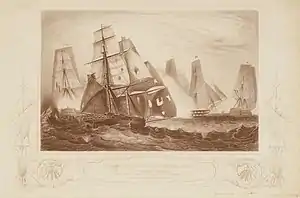 Intrepid behaviour of Captain Charles Napier, in HM 18-gun Brig Recruit for which he was appointed to the D'Hautpoul. The 74 now pouring a broadside into her. April 15, 1809. D'Hautpoul can be seen in the background. | |
| History | |
|---|---|
| Name | D'Hautpoul |
| Namesake | General Jean-Joseph Ange d'Hautpoul |
| Builder | Frères Crucy at Lorient shipyard |
| Laid down | June 1803 |
| Launched | 2 September 1807 |
| Completed | February 1808 |
| Captured | 17 April 1809 |
| Name | Abercrombie |
| Acquired | April 1809 |
| Honours and awards | Naval General Service Medal with clasp "Guadaloupe"[1] |
| Fate | Sold 1817 |
| General characteristics [2] | |
| Class and type | Téméraire-class ship of the line |
| Displacement |
|
| Length | 55.87 metres (183.3 ft) (172 pied) |
| Beam | 14.90 metres (48 ft 11 in) |
| Draught | 7.26 metres (23.8 ft) (22 pied) |
| Propulsion | Up to 2,485 m2 (26,750 sq ft) of sails |
| Armament |
|
| Armour | Timber |
D'Hautpoul was a Téméraire class 74-gun French Navy ship of the line launched at Lorient on 2 September 1807. She was previously named Alcide and Courageux.
French service
On 16 February 1809 Captain Amand Leduc, Chevalier of the Légion d'honneur, commanded D'Hautpoul on her maiden voyage, a mission to Martinique with reinforcements and supplies, as the flagship of a squadron of three 74-gun ships. (The other vessels were Courageux and Polonais), and two frigates, under the overall command of Commodore Amable Troude.) Learning of the capture of Martinique, Troude's squadron turned back but was pursued by the British.[3]
D'Hautpoul was captured by her now-British sister ship HMS Pompée, on 17 April 1809 off Puerto Rico after a chase over three nights and two days by Pompée, HMS Recruit, and HMS Neptune.[4] Recruit hung on the tail of the French squadron and managed to cripple D'Hautpoul's mizzen mast, so Pompée could bring her to action and capture her after exchanging fire for 75 minutes. Between 80 and 90 men from D'Hautpoul were killed or wounded, including several officers.[5]
British service
Taken as a prize, she was renamed Abercrombie, and was briefly given to the commander of Recruit, Charles Napier, who was made post captain for his part in the action, as acting captain. Captain William Fahie of Pompée, who had fallen ill after capturing her, then replaced Napier.
Abercrombie participated in the capture of Guadeloupe in January and February 1810.[6][lower-alpha 1] In 1847 the Admiralty awarded the Naval General Service Medal with clasp "Guadaloupe" to all surviving participants of the campaign.
In February 1810 Captain Fahie was appointed a commodore to assist with landings.[8] His squadron comprised Abercrombie, Vimiera, Snap, Morne Fortunee, Frolic, Surinam, Superieure, and Ringdove.[9] The squadron arrived off St Martin's on 14 February, and the combined might of the ships and a company of the 25th Regiment of Foot forced the French and Dutch occupants to surrender by 16 February.[9][10] On 21 February Abercrombie sailed to Saint Eustatius with Ringdove; the island also quickly capitulated.[9]
After being repaired at Plymouth at the cost of £16,375, Abercrombie sailed for Portugal on 30 December 1810 as part of Admiral George Berkeley's squadron off Lisbon.[6] On 5 September 1811 she took the French brigs Les Deux Amis and Le Jean Baptiste, and the sloop La Marie French while in company with Pompée, HMS Dryad, and HMS Arrow.[11] While she was at anchor in the Basque Roads on 26 October 1811, lightning damaged her fore topmast and foremast.
Between 1812 and 1813 Abercrombie served in the English Channel. On 14 January 1813 Abercrombie, still under the command of Captain Fahie, recaptured the British trader Industry.[12] On 17 July 1813 she shared the proceeds of the capture of Union with HMS Dublin, and on 17 December captured Marie Antoinette.[13][lower-alpha 2]
Fate
By May 1814 Abercrombie was lying decommissioned in the Hamoaze. She was sold for £3,810 at Plymouth on 30 April 1817.[6]
See also
Notes
Citations
- ↑ "No. 20393". The London Gazette. 26 January 1849. p. 243.
- ↑ Clouet, Alain (2007). "La marine de Napoléon III : classe Téméraire – caractéristiques". dossiersmarine.free.fr (in French). Archived from the original on 23 March 2013. Retrieved 4 April 2013.
- ↑ Laird Clowes, The Royal Navy vol. 5, p.435.
- ↑ Laird Clowes, The Royal Navy vol. 5, p.559.
- ↑ Laird Clowes, The Royal Navy vol. 5, p.436.
- 1 2 3 Winfield, British Warships, p. 226.
- ↑ "No. 16938". The London Gazette. 24 September 1814. pp. 1923–1924.
- ↑ Laird Clowes, The Royal Navy vol. 5, p.290.
- 1 2 3 Michael Phillips. Abercrombie (74) (1809). Michael Phillips' Ships of the Old Navy. Retrieved 7 March 2021.
- ↑ "No. 16356". The London Gazette. 31 March 1810. p. 487.
- ↑ "No. 16620". The London Gazette. 4 July 1812. p. 1305.
- ↑ "No. 16770". The London Gazette. 4 September 1814. p. 1753.
- ↑ "No. 16926". The London Gazette. 16 August 1814. p. 1665.
- ↑ "No. 17025". The London Gazette. 17 June 1815. p. 1171.
References
- Clowes, William Laird (1898) The Royal Navy: A History from the Earliest Times to 1900 Volume Five. Sampson Low, Marston and Company. ISBN 1-86176-014-0
- Roche, Jean-Michel (2005). Dictionnaire des bâtiments de la flotte de guerre française de Colbert à nos jours 1 1671–1870. ISBN 978-2-9525917-0-6. OCLC 165892922.
- Winfield, Rif (2008). British Warships in the Age of Sail 1793–1817: Design, Construction, Careers and Fates. Seaforth. ISBN 978-1-86176-246-7.
External links
- Benyon, P. (2011). "HMS Abercrombie". Index of 19th Century Naval Vessels.